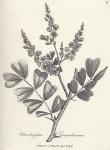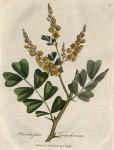
 Synonyma. Lignum Campechense. Pharm. Lond. & Edin.
Synonyma. Lignum Campechense. Pharm. Lond. & Edin.
Haematoxylum spinosum, foliis pinnatis, racemis terminalibus. Browne's Jam. 221.
Lignum Campechianum, species quaedam Brasil. Vide Sloanes Jam. vol. 2. p. 183.
Crista pavonis Coronillae folio secunda, sive tinctoria Indica, flore luteo racemoso minore, siliqua latissima glabra, lignum rubrum, Sappan dictum ferens. Breyn. Prodr. 2. 37.
Erythroxylum, sive lignum rubrum Indicum spinosissimum, coluteae foliis, floribus luteis, filiquis maximis. Herm. Par. Bat. 333.
Haematoxylum.
Class Decandria. Order Monogynia. L. Gen. Plant. 525.
Ess. Gen. Ch. Cal. 5 partitus. Petala 5. Caps, lanceolata, 1-locularis, 2-valvis: valvis navicularibus.
The Campechianum is the only species of the Haematoxylum hitherto discovered; it is a much smaller tree than the Guaiacum, and both the trunk and the branches are extremely crooked, and covered with dark-coloured rough bark; the smaller ramifications are numerous, close, prickly, or beset with strong sharp spines; the leaves are pinnated, generally composed of four or five pair of pinnae, of an irregular oval shape, obliquely nerved, and obtusely sinuated at the top; the flowers grow in racemi, or in close regular terminal spikes, and appear in March; the calyx divides into five oblong obtuse segments, of a brownish purple colour; the petals are five, patent, obtusely lance-shaped, and of a reddish yellow colour; the stamina are somewhat hairy, tapering, of unequal length, shorter than the corolla, and the antherae are small and oval; the style is nearly the length of the stamina, and the germen becomes a long double valved pod, which contains many oblong compressed, or somewhat kidney-shaped, seeds.
This tree is a native of South America, and grows to the highest perfection at Campeachy, in the Bay of Honduras, whence the seeds were brought to Jamaica in 1715, with a view of propagating it as an article of commercial export. And though it does not appear to have answered this purpose so fully as could have been wished, yet we are told that in some parts of the island, especially where the ground is swampy, this tree, in the course of three years, will rise to the height of ten feet, and by this quick and luxuriant growth, soon overrun and destroy the neighbouring plants. [In some parts of Jamaica "are such quantities of it growing wild, as to incommode the land-holders extremely." Long's l. c. 754. He also observes, that "it makes an excellent and beautiful fence, which, if kept properly trimmed, grows so strong and thick, that nothing can break through."] The Logwood tree was first cultivated in Britain by Mr. P. Miller in 1739 [Hort. Kew.] who says, "there are some of these plants now in England which are upwards of six feet high, and as thriving as those in their native soil;" [Dictionary abridged, sixth edition.] but this observation will not apply to the present time, for we have searched in vain for this plant through molt of the principal garden stoves in the neighbourhood of London.
The wood of this tree is of a solid texture, and of a dark red colour; it is imported into Europe principally as a dying drug, cut into junks or logs of about three feet in length; of these pieces, the largest and thickest are preferred, as being of the deepest colour. This wood has a sweetish subastringent taste, and no remarkable smell; it gives a purplish red tincture both to watery and spirituous infusions, and tinges the stools, and sometimes the urine, of the same colour; but from the experiments of DuHamel and others, it does not appear to colour the bones of animals, as observed of madder and some other plants of that class. It is used medicinally as an astringent and corroborant. In diarrhoeas it has been found peculiarly efficacious, and has the recommendation of some of the first medical authorities: [Baker, Clark, Pringle, Duncan, Zimmerman, Baldinger, and others.] also in the latter stages of dysentery, when the obstructing causes are removed, to obviate that extreme laxity of the intestines usually superinduced by the repeated dejections. Extractum ligni campechensis is ordered in the pharmacopoeias, and may be given in the dose of one scruple or two, repeated according to the urgency of the symptoms.

